Colossal clouds loom overhead as raindrops begin to patter against the water’s surface. Many people might decide to stay cozy indoors on such a day, but for a passionate kayaker like myself, it’s an invitation to embark on a new adventure. Conquering the elements while slipping through the water, I find myself in a world of serene solitude, colors transforming, and the sound of rainfall becoming a soothing accompaniment to each paddle stroke.
This begs the question: Can you kayak in the rain? As experience has taught me, the answer is a resounding yes! However, there are essential tips and precautions to keep in mind to ensure that your rainy kayaking expedition is not only thrilling but also safe. Join me as we take a (paddle) dip into this fascinating question.
Contents
Contents
Preparing For Rainy Kayaking Adventures
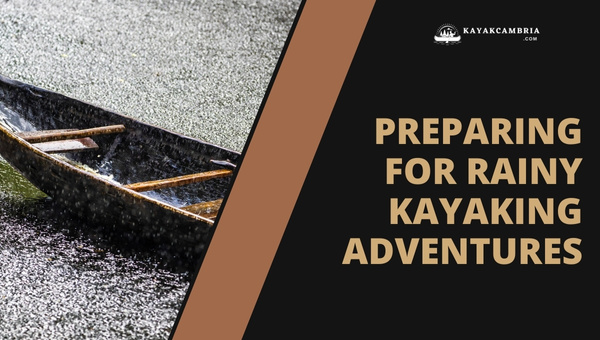
Whether you’re heading out deliberately for a rainy paddle or you’re simply caught in some unexpected showers, being prepared is key to enjoying your time on the water. As a kayaker, there are several steps I take to gear up for my wet weather adventures. Here, I’ll share my top tips so that you too can face the elements with confidence.
1. Check the Weather Forecast
It’s important to keep a close eye on the local weather forecast before heading out. If heavy rainfall or storms are predicted, it might be wise to postpone your trip for another day. Keep an eye on radar maps and apps to stay updated on changes in conditions.
2. Familiarize Yourself with the Waterway
In heavy rains, water levels in rivers and lake shores can rise quickly, and currents can become stronger. Take the time to study the water flow and potential obstacles in the area you plan on paddling. Familiarizing yourself with the waterway will help you anticipate any potential hazards. Check with local authorities, parks, or paddling clubs for the most up-to-date information.
3. Pack the Right Gear
Rainy days require a few extra essentials to keep you safe and comfortable during your paddling adventure. A few items I never leave shore without include:
- A dry bag to keep my essential gear dry and protected
- An extra paddle in case of any unexpected breakage or loss
- A waterproof map or GPS device to stay on track and navigate confidently in low visibility conditions
- A headlamp or flashlight to illuminate your surroundings as needed
4. Be Mindful of the Water Temperature
Cold water and rain can be a dangerous combination, leading to hypothermia if you’re not adequately prepared. Be sure to monitor the water temperature and dress accordingly to ensure you remain warm throughout your adventure. In most areas, a wetsuit or drysuit may be necessary to keep you safe and comfortable in colder water.
By taking the proper precautions, you can have a fantastic kayaking experience in the rain. So next time the skies open up, don’t let it put a damper on your paddling plans. Instead, embrace the challenge and enjoy the beauty of nature’s rain-soaked scenes from the comfort of your kayak!
Chaotic Weather Or Serene Scenery: The Silver Lining Of Rainy Kayaking
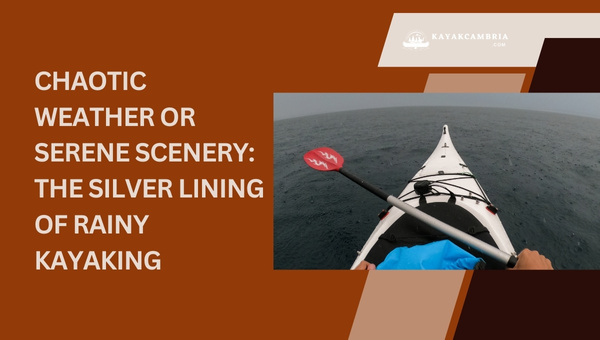
Rainy days often have a calming effect on our surroundings, and when we venture out for a kayak trip, the experience can be transcendent. Despite the potential challenges that accompany kayaking in the rain, there are some unique aspects that make these experiences especially rewarding.
Enjoying the Solitude and Serenity of Nature
As many paddlers generally avoid venturing out in the rain, you’ll find that the waterways are significantly less crowded these days. This allows for a more tranquil kayaking experience, free from the hustle and bustle of everyday life. As you glide through the water, you’ll experience a heightened sense of peacefulness and serenity—embracing the beauty of nature in all its forms.
Observing the Beauty of Rain on the Water
Raindrops interacting with the water’s surface create mesmerizing patterns and ripples, causing a symphony of sensory delights. The soothing sound of rain gently tapping against the kayak and the glistening droplets that scatter across the surface add texture to an otherwise placid scene. This visual and auditory display beats any relaxing ambiance you might find in the comfort of your home.
Unique Wildlife Sightings
Rainy days also offer a rare opportunity for observing unique wildlife species. Many animals and birds take advantage of the wet conditions to forage for food or exhibit fascinating behaviors. Keep your eyes open and your camera ready, for you might be lucky enough to capture memorable encounters with these elusive creatures.
Taking to the water in the rain provides a different perspective on the world, offering a rare glimpse of a landscape that few ever encounter. Kayaking in the rain, though potentially challenging, creates a bridge to a natural world that often remains hidden from view, leaving all who experience it feeling revitalized and truly at one with nature.
Staying Safe In The Storm
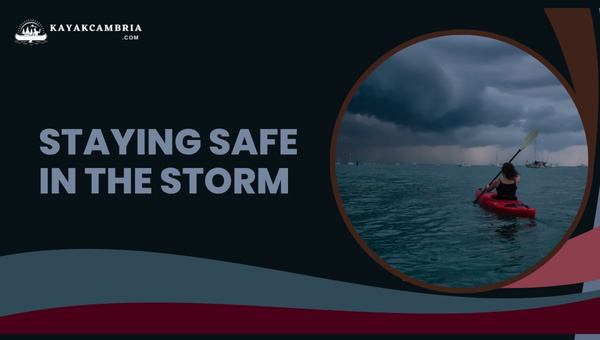
Rainy weather can bring a certain level of uncertainty to any kayaking excursion. However, by taking the necessary precautions and being vigilant, you can ensure a pleasant and safe experience on the water. Here are some important tips to keep in mind when paddling in stormy conditions:
1. Check Weather Conditions and Forecasts
Before embarking on your kayaking adventure, it’s crucial to check the weather forecast for any unexpected changes or potential hazards like heavy rain, strong winds, or approaching storms. Make sure to stay informed about the conditions in your area with reliable sources such as local weather stations, online resources, or mobile apps.
2. Beware of Lightning
Lightning can be a serious safety concern when kayaking in the rain. If you hear thunder, see lightning, or the weather takes a turn for the worse, it’s time to seek shelter on land immediately. Avoid seeking refuge under tall or isolated trees, as these can attract lightning. Instead, opt for low-lying terrain and avoid metal objects.
3. Ensure You Have Proper Gear
Kayakers should always be prepared with essential safety gear, such as a personal flotation device (PFD), paddle leash, and foot braces to maintain stability and minimize potential hazards. Additionally, always inform others of your intended route and estimated time of return in case of an emergency.
4. Have a Plan and Tell Others
Before setting out, create a kayaking plan and make sure to tell someone trustworthy (e.g., friends, family, or the local park authority) about your route, launch and return times, and any potential stops. If any problems arise or if you need assistance, having someone aware of your location can prove invaluable in ensuring your safety.
By following these guidelines, you can face the rain with confidence and stay safe while enjoying the unique paddling experience it presents.
Dressing Appropriately For A Rainy Paddle
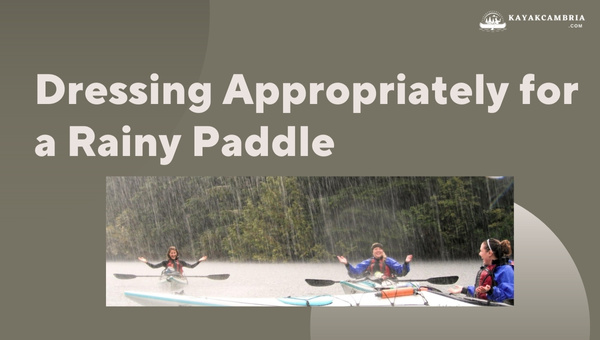
When kayaking in the rain, it’s essential to dress appropriately to stay comfortable and dry during your adventure. Proper attire not only ensures you won’t find yourself chilled to the bone, but it also helps keep your spirits high even as the rain continues to fall. Here are some key considerations for dressing to paddle in wet weather:
1. Waterproof Layers
A good quality, breathable waterproof jacket and pants are indispensable when kayaking in the rain. These should be worn over your base and insulating layers, keeping water out while still allowing for ventilation. GORE-TEX® or similar waterproof, breathable fabrics are ideal choices. Consider wearing a hat with a wide brim or a waterproof cap to shield your face from raindrops.
2. Non-Cotton Clothing
When dressing for a wet paddle, avoid cotton clothing as it absorbs water, losing its insulating properties when wet. Instead, opt for synthetic materials like polyester or nylon, which dry quickly and retain warmth even when damp. When choosing your base and insulating layers, consider wearing moisture-wicking or quick-drying materials for optimal comfort.
3. Extra Layers and Dry Gear
Rain can be unpredictable, so bringing extra layers to change into if needed can make a big difference in your comfort. Additionally, pack spare clothes and gear (e.g., socks, gloves) in a dry bag to ensure they stay dry until needed. This extra preparation will help you combat any sudden temperature changes or prolonged exposure to rain.
Remember, safety and comfort go hand-in-hand when you’re out on the water. Dressing appropriately for a rainy paddle enables you to embrace the elements and focus on the beauty of your surroundings, rather than being preoccupied with staying warm and dry. By taking the time to prepare and dress accordingly, you’re one step closer to enjoying a memorable rain-soaked kayaking adventure.
The Importance Of A Well-Equipped Kayak
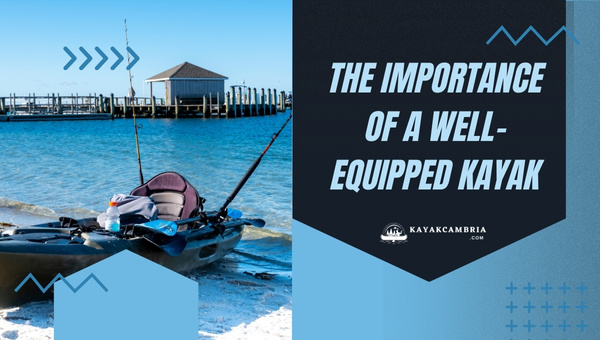
As any experienced kayaker will tell you, a well-equipped kayak is essential for any kind of paddling adventure, and this is even more crucial when you’re out in the rain. Certain accessories can greatly enhance your safety, comfort, and overall enjoyment while navigating the waters during rainy conditions. Let’s explore some of the essential gear that will come in handy when kayaking in the rain.
1. Kayak Spray Skirt
A spray skirt is a flexible and waterproof cover that fits around your waist and the cockpit of your kayak. Its primary purpose is to prevent water, like rain or waves, from entering the cockpit, thus keeping you and your kayak’s interior dry. Using one is especially important during rainy paddles to minimize the amount of water that gets into your kayak.
2. Bilge Pump or Sponge
It’s normal for some water to find its way into your kayak, especially when paddling in the rain. To promptly get rid of this excess water, be sure to equip your kayak with either a bilge pump or a sponge. A bilge pump allows you to quickly and efficiently expel water from your kayak, while sponges can be used to soak up any remaining moisture.
3. Kayak Cover
A kayak cover is a valuable accessory that protects both you and your kayak from the elements while you’re on the water. Also known as a cockpit cover, it serves as a barrier against rain, wind, and even sunlight. When you need to take a break during rainy conditions, a kayak cover can offer much-needed shelter, allowing you to stay dry and warm until you’re ready to start paddling again.
In addition to the above gear, it’s essential to ensure that your kayak has essential safety features like paddle leashes and foot braces. A well-equipped kayak goes a long way in making your rainy paddling adventure safe, comfortable, and enjoyable.
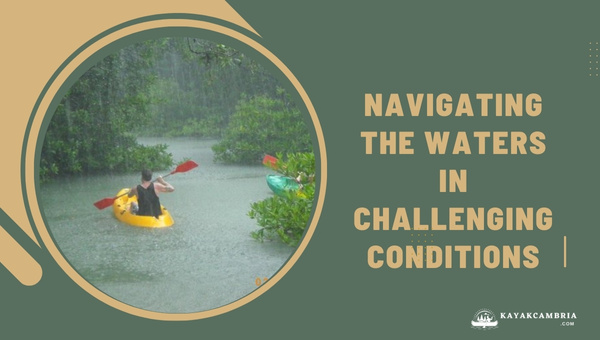
When kayaking in the rain, it’s crucial to remain vigilant and adapt to the challenges presented by Mother Nature. Rain can dramatically change the conditions and hazards out on the water, so it’s essential to be well-prepared and maintain a clear head amid the downpour. Below, I’ll share some essential tips and considerations for navigating rainy waters safely and effectively.
Be Attentive to Water Levels and Currents
In heavy rain, rivers and other bodies of water may rise and currents might become stronger, putting even experienced kayakers to the test. Therefore, it’s essential to stay mindful of changing water levels and currents and adjust your course as needed. Keep an eye out for visual indicators of water flow rates and direction. Additionally, be cautious of water sources like storm drains, as heavy rain may cause them to expel more water into the surrounding environment.
Recognize Any Potential Hazards
Rain might obscure your vision, making it more difficult to see potential hazards such as submerged rocks, fallen trees, or debris floating in the water. Pay extra attention to your surroundings and be ready to make quick decisions to avoid any obstacles. Checking the area beforehand, if possible, will give you a rough idea of what to expect, while waterproof maps or a GPS system can aid in navigating unfamiliar waters.
Communicate with Fellow Paddlers
When embarking on a group kayaking adventure in the rain, effective communication is vital to keeping everyone safe. Make sure to establish a set of hand signals or other non-verbal communication methods, especially since rain can diminish the effectiveness of verbal cues. Always be aware of your fellow kayakers’ positions, as heavy rain can reduce visibility. Establishing a buddy system or staying in a close-knit formation can reduce the likelihood of becoming separated or losing sight of each other.
Navigating challenging conditions in the rain might seem daunting, but by heeding these guidelines and adopting a proactive mindset, you can overcome any difficulties and enjoy an exhilarating, unforgettable kayaking experience.
Paddle Techniques And Strategies For Kayaking In The Rain
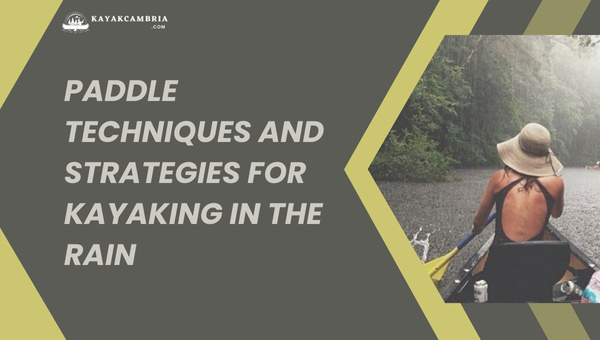
Rainy weather can add some challenges to your kayaking experience, but with the right paddle techniques and strategies, you can continue enjoying your adventure despite the impending wet conditions. Here, we’ll take a look at some effective paddle techniques tailored specifically for kayaking in the rain.
Adjusting Paddle Angle and Cadence
Paddling in the rain can affect your grip, so it’s essential to make sure you’re holding your paddle securely. To maintain an efficient stroke in wet conditions, consider adjusting your paddle angle – opt for a more vertical stroke – to ensure a cleaner entry into the water and minimize any wind resistance. Additionally, increasing your stroke cadence can help keep your kayak moving smoothly and counteract the resistance generated by the falling rain.
Utilize Eddies to Avoid Working Against Currents
In heavy rain, water levels can rise, causing increased current and turbulence. When navigating through these conditions, be on the lookout for eddies: areas of calm or counter-current waters adjacent to the main current flows. By learning to recognize these areas and maneuvering your kayak into them, you’ll be able to avoid exerting unnecessary energy against the current and give yourself a chance to rest or regroup.
Practice Bracing Techniques for Increased Stability
As raindrops pelt your kayak, the surface of the water will become choppy, and consequently, your kayak will be more prone to wobbling. Being able to maintain stability and stay upright is crucial to paddle effectively in the rain. High and low brace techniques act as a support system to help you maintain balance and control while navigating in these potentially tricky conditions. So be sure to practice these crucial bracing techniques to ensure a safe and enjoyable rainy kayaking experience.
Hitting The Pause Button: Taking Breaks In The Rain
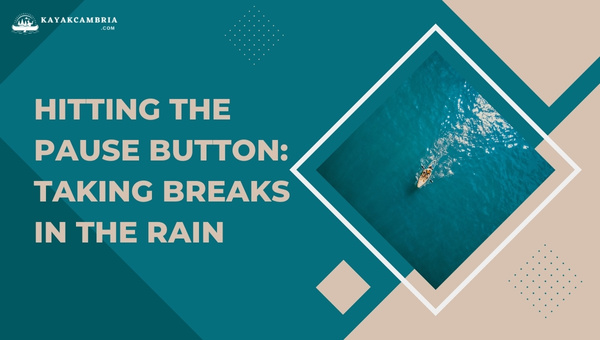
Even during our rainy kayaking adventures, it’s essential to take breaks to recharge physically and mentally. Taking breaks in the rain can be an enjoyable way to appreciate the beauty of our surroundings and ensure a safe and comfortable journey.
Identifying Suitable Areas for Onshore Breaks
When planning your route, consider identifying suitable areas along the shoreline for taking breaks. Look for areas that provide some shelter from the rain, like overhanging trees or rock outcrops, which can offer a temporary respite from the downpour. Natural areas that provide a stable spot to come ashore will also allow for easy entry and exit of your kayak.
Pack Snacks, Warm Beverages, and Dry Clothes for Quick Rejuvenation
During your breaks, a warm beverage in a thermos, such as hot chocolate or coffee, can provide much-needed warmth and comfort. Packing energy-boosting snacks and sandwiches will give you the sustenance to keep you going during your paddle. Be sure to pack extra dry clothes, preferably in a waterproof bag, which will help prevent hypothermia and increase your overall comfort during breaks.
Embrace the Beauty of the Rain-Soaked Scenery
In the midst of a rain-soaked drizzle, taking time to embrace the beauty of nature can be a fascinating experience. During breaks, try to capture the beauty of the landscape around you through photography, sketching, or simply engaging in quiet contemplation. As the rain falls and creates unique patterns on the water’s surface, observe how the mist accentuates the contours of the hills and valleys. These rare moments of quietude in the midst of a rainstorm make for excellent storytelling and help create lasting memories of your kayaking adventure.
By hitting the pause button and taking breaks during your rainy kayak trip, you’ll be ensuring a safe, comfortable, and memorable experience. Enjoy the tranquility that comes from being immersed in nature and don’t forget to find joy in the rain. After all, the memories you create while kayaking in the rain will be cherished long after the clouds have parted.
Kayaking In The Rain: Family-Friendly Adventures

Rainy days don’t have to mean staying indoors, especially when it comes to family-friendly activities like kayaking. With the right precautions, mindset, and gear, turning a damp day into a memorable adventure for the whole family can create lasting impressions and foster a love of nature for years to come. Here are some tips for keeping kids engaged, comfortable, and safe during rainy kayak trips.
Tips for a Fun and Safe Experience
- Engaging Activities: Turn kayaking in the rain into a playful adventure. Encourage children to observe the patterns raindrops make on the water or try catching raindrops on their hands as they paddle. Incorporate a little competition by seeing who can paddle through the most raindrops.
- Dress Appropriately: Make sure everyone is wearing the right gear to stay warm and dry. Waterproof layers, non-cotton clothing, and hats will help keep kids comfortable, even when getting splashed by rain. Pack extra clothes and gloves in waterproof bags, so they can change into something dry and warm during breaks.
- Choose a Safe Location: Select a calm, easily navigable waterway, preferably with shallow water. Avoid water bodies with strong currents or tides. Familiarize yourself with the area, keeping an eye on any potential hazards like submerged rocks or fallen trees.
- Keep the Journey Short & Sweet: To ensure a positive experience for all, plan a shorter trip. Younger children may tire more easily and lose enthusiasm during a long rainy paddle.
Embrace the Elements and Learn From Nature
Experiencing the beauty of nature, even when it’s rainy, can teach children about resilience and adaptation. Acknowledging the value of appreciating and embracing all types of weather can lead youngsters to develop a more balanced and nuanced perspective of their environment.
The Virtues of Patience and Empathy
Kayaking in the rain can also help teach the virtues of patience and empathy, as family members must work together to navigate challenging conditions. Communication and cooperation become crucial, instilling the importance of teamwork and understanding each other’s needs and limitations.
So, throw on your rain gear and pack up the family for an unforgettable adventure! By following these tips and guidelines, kayaking in the rain can be a rewarding, educational, and enjoyable experience that leaves the whole family with cherished memories.
The Environmental Impact Of Paddling In The Rain
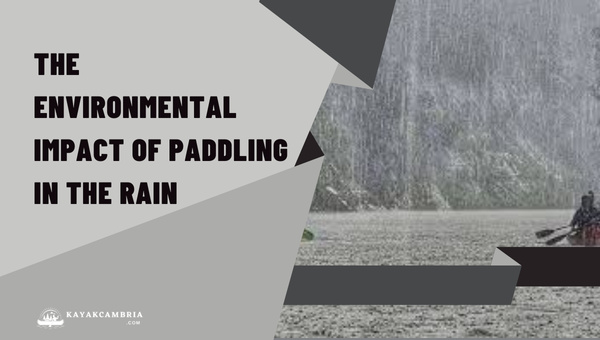
When we head out for a kayaking adventure, it’s essential to consider the potential environmental impact of paddling in the rain. While we may be enjoying the serenity and unique atmosphere, the rainy weather can also bring certain ecological risks that we must be aware of as responsible kayakers.
Increased Water Pollution
Rainstorms can stir up sediment from the shorelines and introduce pollutants into the water. These pollutants may include chemicals, pesticides, and waste that make their way into waterways due to runoff from urban and agricultural areas. As paddlers, it’s crucial to be aware of this fact so that we can avoid contributing to water pollution. Be sure not to discard trash or unwanted gear during your paddling session, and always practice the Leave No Trace principles.
Erosion and Shoreline Impacts
Heavy rain can cause increased erosion along shorelines and riverbanks, potentially leading to landslides and loss of habitat for various species. Additionally, the swells and currents caused by the rain might weaken the shorelines’ stability. As kayakers, we must be cautious not to contribute to this erosion. Paddle close to the shore only when it’s necessary, and refrain from trampling or damaging vegetation.
Overtaxing Infrastructure and Increased Sedimentation
Rain events can also overtax stormwater and wastewater management systems, which may lead to sewage overflow into waterways. This can negatively impact water quality and aquatic habitats due to increased nutrient levels and sediment. While it might not be in our control, it serves as a reminder to be mindful of our surroundings and educate ourselves about local water quality issues.
Responsible and Sustainable Paddling Habits
The key to minimizing the environmental impact of paddling in the rain is to practice responsible and sustainable kayaking habits. This can include the following:
- Paddling close to the shore only when necessary
- Sticking to durable surfaces, such as sand or gravel, when going ashore
- Observe wildlife from a respectful distance, and never feed or harass animals
- Avoid areas with sensitive ecosystems or nesting sites
By acknowledging and respecting the potential environmental impacts of kayaking in the rain, we can continue to enjoy the beauty and serenity of these unique paddling adventures while ensuring that our beloved waterways remain clean, healthy, and teeming with life for years to come.
Post-Paddle: Taking Care Of Your Gear After A Rainy Adventure
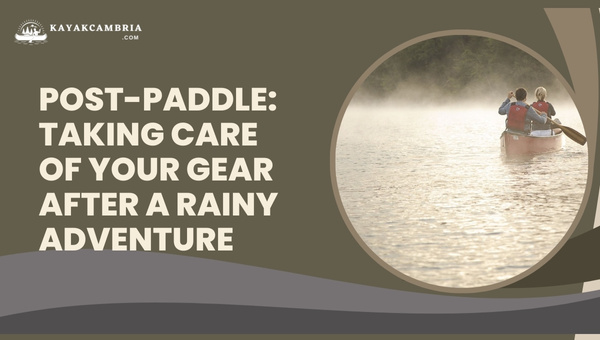
As much joy and serenity as I find in kayaking in the rain, I know that taking care of my gear afterward is essential to maintaining its peak performance – and to ensuring I’m always prepared for the next adventure. Here are some crucial steps to follow for proper post-paddle care.
Cleaning Your Kayak, Paddle, and Gear
A thorough cleaning is crucial to prevent any dirt, mud, and debris from causing long-term damage to your equipment. Gently hose down your kayak, paddle, and any other gear you’ve used, focusing on areas where dirt and debris may accumulate, such as the kayak’s footpegs and seat. If necessary, use a mild, eco-friendly soap to help remove stubborn grime.
Drying Your Equipment
To prevent mold and mildew growth, always dry your gear completely after each outing. Hang your life jacket, paddling gloves, and other clothing items in an airy space, ideally indoors, for proper drying. Leave the kayak’s hatches open or remove them if possible and use a towel to wipe any excess water from the cockpit and compartments.
Inspecting and Repairing Damages
While cleaning and drying your gear, take the opportunity to inspect everything thoroughly. Look for any signs of damage, such as scratches, dents, or wear that may require repair. Address any issues promptly to avoid exacerbating them, potentially leading to costly replacements.
Proper Storage and Transport
Store your kayak and gear in a cool, dry place away from direct sunlight to prolong the life of your equipment. Use kayak storage racks or padded supports to keep the kayak off the ground, and always secure it with straps to prevent accidental damage. For your paddle, life jacket, and other gear, consider designated storage areas—like hooks or bins—so everything stays organized and easily accessible for your next rainy-day adventure.
Consistent care and maintenance of your kayaking gear not only prevent damage but also help ensure your safety on the water. As I’ve discovered over many rainy paddles, taking the time to care for my gear has always been well worth the effort.
Frequently Asked Questions
1. Is it safe to kayak in the rain?
Yes, it is generally safe to kayak in the rain, as long as you are properly prepared and take necessary precautions. Always check the weather forecast and be aware of any potential severe conditions, dress appropriately, and ensure you and your kayak are well-equipped for the adventure.
2. What should I wear kayaking in the rain?
When kayaking in the rain, it is crucial to wear a waterproof layer to stay dry. Opt for non-cotton clothing that retains warmth even when wet, and bring extra layers and dry gear in case you need to change during the trip.
3. How do I keep my kayak from filling with water during rain?
Invest in a kayak spray skirt that covers the cockpit and prevents water from getting inside the kayak. Additionally, a bilge pump or sponge can be used to remove any water that finds its way in.
4. How should I clean and store my kayak after a rainy outing?
Thoroughly clean your kayak, paddle, and gear with fresh water to remove dirt, debris, and potential contaminants. Dry your equipment completely to prevent mold and mildew growth, and store it in a cool, dry place away from direct sunlight.
5. Can I go kayaking in the rain with the kids?
Yes, you can kayak in the rain with kids, as long as you take proper precautions and ensure their comfort and safety. Keep kids engaged, provide appropriate clothing, and teach them to embrace the elements while learning from nature.
6. How will kayak in the rain impact the environment?
Rainy conditions can lead to increased water pollution and erosion on shorelines and waterways. Be aware of these potential risks and practice responsible, sustainable paddling habits to protect the environment.
7. How do I improve my paddle technique for kayaking in the rain?
To better navigate rainy conditions, adjust your paddle angle and cadence, taking advantage of eddies to avoid fighting against currents. Also, practice bracing techniques to increase your stability on the water during storms.
Conclusion
As we paddle our way to the end of this discussion, it’s clear that kayaking in the rain is not only possible but can also be an enjoyable and memorable experience. With proper preparation, mindfulness of safety, and an appreciation for what Mother Nature has to offer, embarking on a rainy day kayak adventure can lead to exciting new discoveries, all while challenging and honing your skills as a paddler.
However, as much as indulging in the beauty of rain-soaked paddling may sound poetic, never forget that your safety comes first. Always be vigilant in assessing the surrounding conditions, and the weather forecast, and understanding the limitations of your own capabilities.
So the next time grey skies appear, ask yourself, “Why not?” Embrace the duality of serenity and adventure with a different kind of kayaking experience – one that invites you to paddle through the rain, echoing the rhythmic melodies of nature, and discovering a newfound sense of harmony and connection with the world around you.

